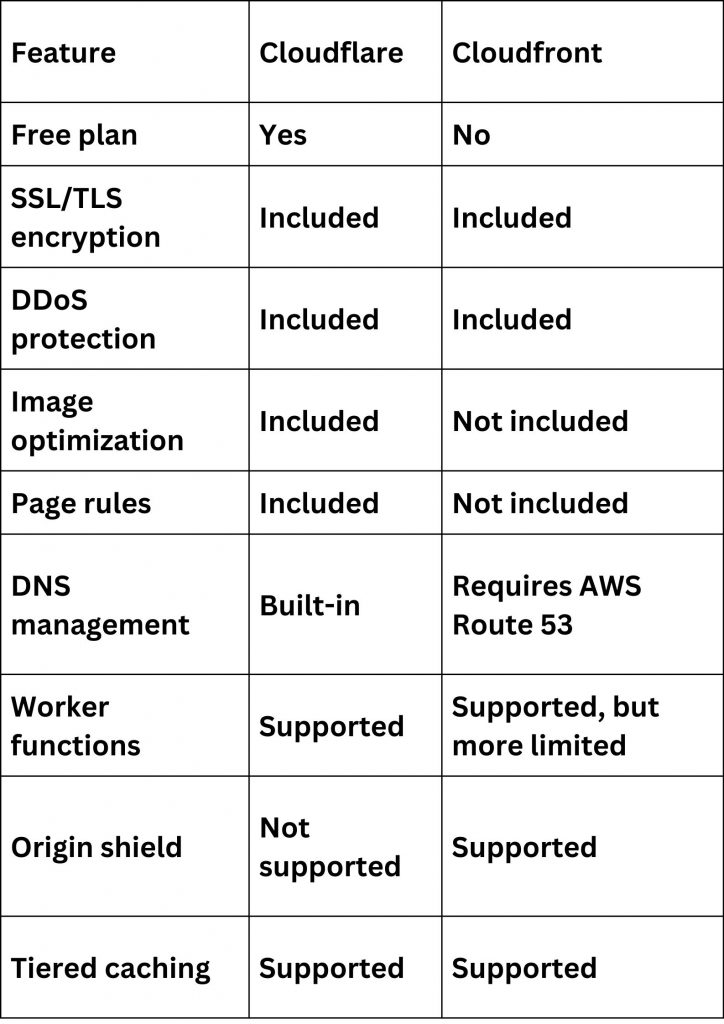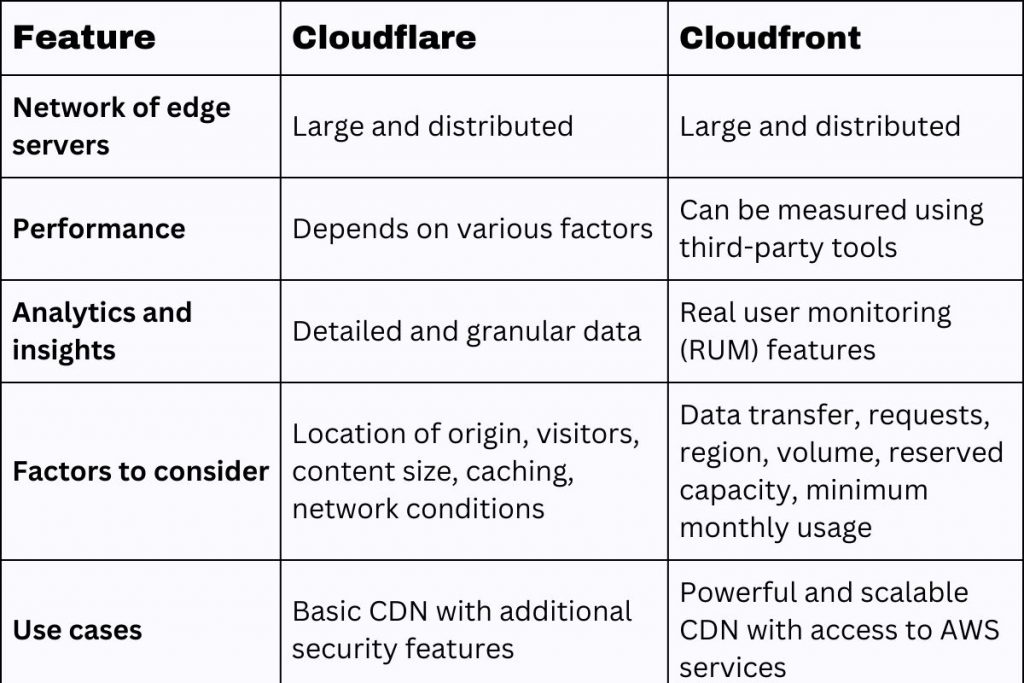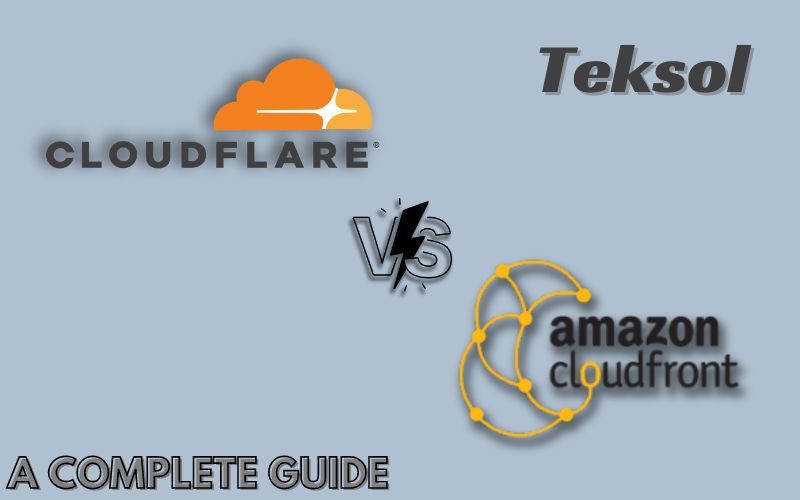Content delivery networks (CDNs) are essential for improving the performance, security, and scalability of your website. They can speed up your content delivery and load times, reduce bandwidth costs, protect your site from malicious attacks, and handle traffic spikes. But how do you choose the right CDN for your needs? In this article, we will compare two of the most popular and reliable CDNs on the market: Cloudflare vs Cloudfront. We will look at their features, pricing, performance, and other key factors to help you make an informed decision.
What is Cloudflare?
Cloudflare is a CDN that acts as a reverse proxy for your website. This means that it sits between your origin server and your visitors, and serves cached content from its global network of edge servers. Cloudflare also provides a range of additional services, such as:
- DNS management
- Web application firewall (WAF)
- DDoS protection
- SSL/TLS encryption
- Image optimization
- Page rules
- Workers (serverless functions)
- Analytics and insights
Cloudflare has a free plan that offers basic CDN and security features, as well as several paid plans that offer more advanced functionality and support. Over 200 data centers in more than 100 countries, and claims to serve over 25 million websites.
What is Cloudfront?
Cloudfront is the CDN service from Amazon Web Services (AWS). It integrates with other AWS services, such as S3, EC2, Lambda, and Route 53, and allows you to deliver your content from AWS edge locations around the world. Cloudfront also offers features such as:
- Origin shield (a layer of caching between your origin and edge servers)
- Field-level encryption (encrypts specific data fields at the edge)
- Lambda@Edge (run custom code at the edge)
- Real-time logs and metrics
- AWS Shield (DDoS protection)
- AWS Certificate Manager (SSL/TLS certificates)
- AWS WAF (web application firewall)
Cloudfront does not have a free plan, but it offers a free trial for 12 months. It charges based on the data transfer and requests, as well as the features you use. It has over 200 edge locations in 78 cities across 37 countries.
Cloudflare vs Cloudfront: Comparison
Now that we have a basic overview of Cloudflare and Cloudfront, let’s compare them on some key aspects:
1- Features
Both Cloudflare and Cloudfront offer a comprehensive set of features for content delivery and security. However, there are some differences in the scope and availability of these features. For example:

- Cloudflare offers more features in its free plan, such as SSL/TLS encryption, DDoS protection, image optimization, and page rules. Cloudfront does not have a free plan, and some of these features are charged separately or require additional AWS services.
- Cloudflare has a built-in DNS service that allows you to manage your domain names and records. Cloudfront relies on AWS Route 53 for DNS, which is a separate service with its own pricing and configuration.
- Cloudflare has a workers feature that lets you run serverless functions at the edge, which can be used for custom logic, routing, or transformations. Cloudfront has a similar feature called Lambda@Edge, but it is more limited in terms of languages, memory, and execution time.
- Cloudfront has an origin shield feature that adds a layer of caching between your origin and edge servers, which can reduce the load on your origin and improve performance. Cloudflare does not have a comparable feature, but it does have a tiered caching feature that allows you to cache content on regional data centers.
Read More From The Teksol: Python For Mobile App Development
2- Pricing
Both Cloudflare and Cloudfront have pay-as-you-go pricing models, but they differ in how they charge for their services. For example:

- Cloudflare has a free plan that offers basic CDN and security features, as well as three paid plans: Pro ($20 per month), Business ($200 per month), and Enterprise (custom pricing). Check out this pricing on their website prices may vary according to up to date versions. The paid plans offer more features, such as WAF, workers, image resizing, and dedicated SSL certificates. Cloudflare also charges for some add-on features, such as Argo (smart routing), Load Balancing, and Stream (video delivery).
- Cloudfront does not have a free plan, but it offers a free trial for 12 months. It charges based on the data transfer and requests, as well as the features you use. The data transfer and request pricing varies by region and volume, and can be reduced by using reserved capacity or committing to a minimum monthly usage. The feature pricing includes charges for origin shield, field-level encryption, Lambda@Edge, real-time logs, AWS Shield, AWS WAF, and AWS Certificate Manager.
- To compare the pricing of Cloudflare and Cloudfront, you need to consider your specific usage and requirements, as well as the features you need. You can use the pricing calculators from both providers to estimate your costs.
3- Performance

i- Comparing the Performance
Both Cloudflare and Cloudfront have a large and distributed network of edge servers that can deliver your content faster and more reliably to your visitors.
However, the performance of a CDN depends on many factors, such as the location of your origin, the location of your visitors, the size and type of your content, the caching and compression settings, and the network conditions. Therefore, it is difficult to compare the performance of Cloudflare and Cloudfront without testing them in real-world scenarios.
ii- Testing with Third-Party Tools
One way to compare the performance of Cloudflare and Cloudfront is to use third-party tools, such as Pingdom, GTmetrix, or WebPageTest, to measure the load time, latency, and throughput of your website with and without the CDN.
You can also use tools like CDNPerf or Cedexis to compare the performance of different CDNs across regions and time periods. However, these tools may not reflect your actual user experience, as they may use different methods, locations, and metrics to measure performance.
iii- Using Analytics and RUM Features
Another way to compare the performance of Cloudflare and Cloudfront is to use their own analytics and insights features, which can provide you with detailed and granular data on your traffic, requests, cache hit ratio, errors, and other performance indicators. You can also use their real user monitoring (RUM) features, which can collect and analyze data from your actual visitors, such as page load time, browser type, device type, and location.
Conclusion
Both Cloudflare and Cloudfront are powerful CDNs that can enhance the performance, security, and scalability of your website. However in comparison of cloudflare vs cloudfront, they have different features, pricing, and performance characteristics that may suit different use cases and preferences.
To choose the right CDN for your website, you should evaluate your needs, compare your options, and test them in your own setting. You may also use a multi-CDN strategy to combine the advantages of various CDNs and provide redundancy and resilience.



